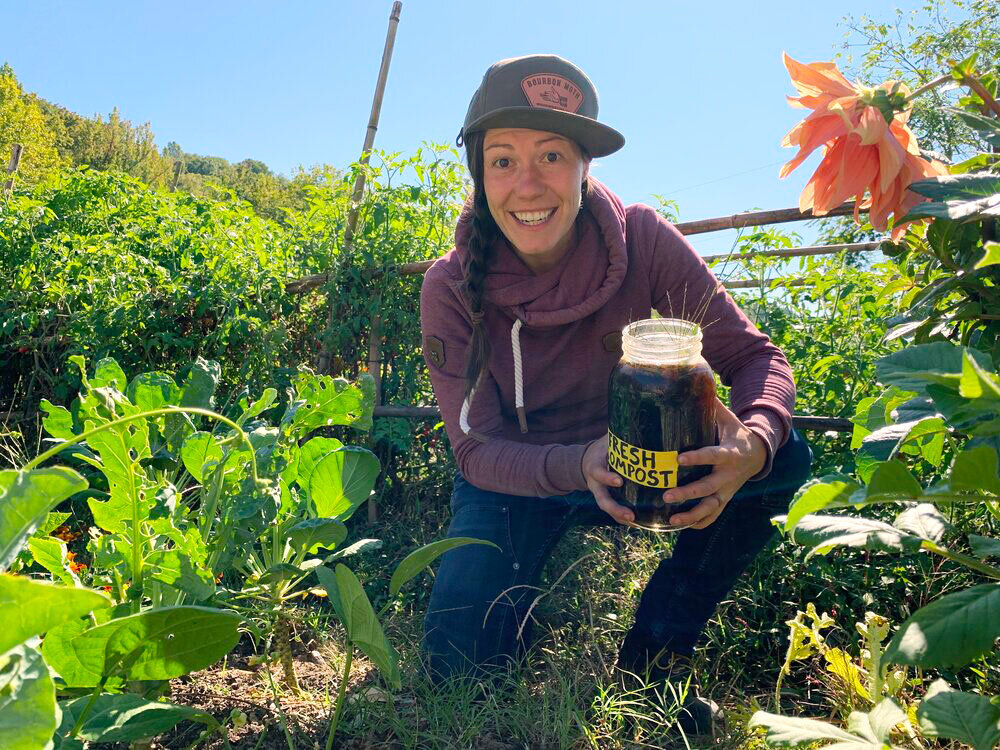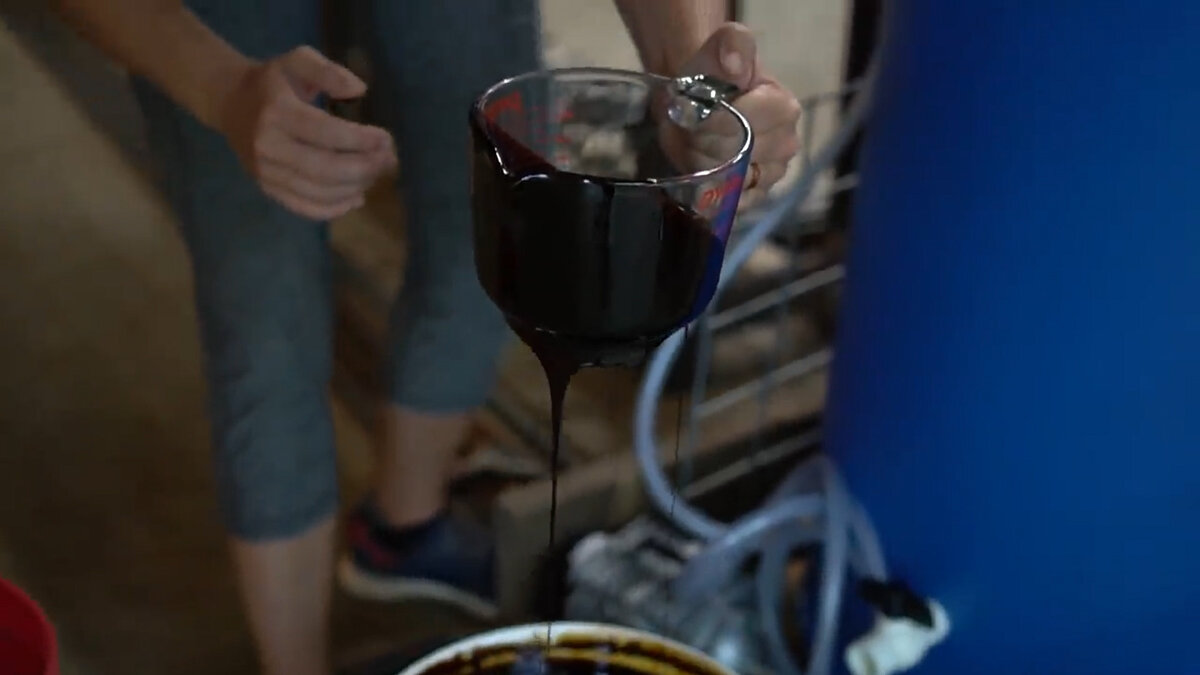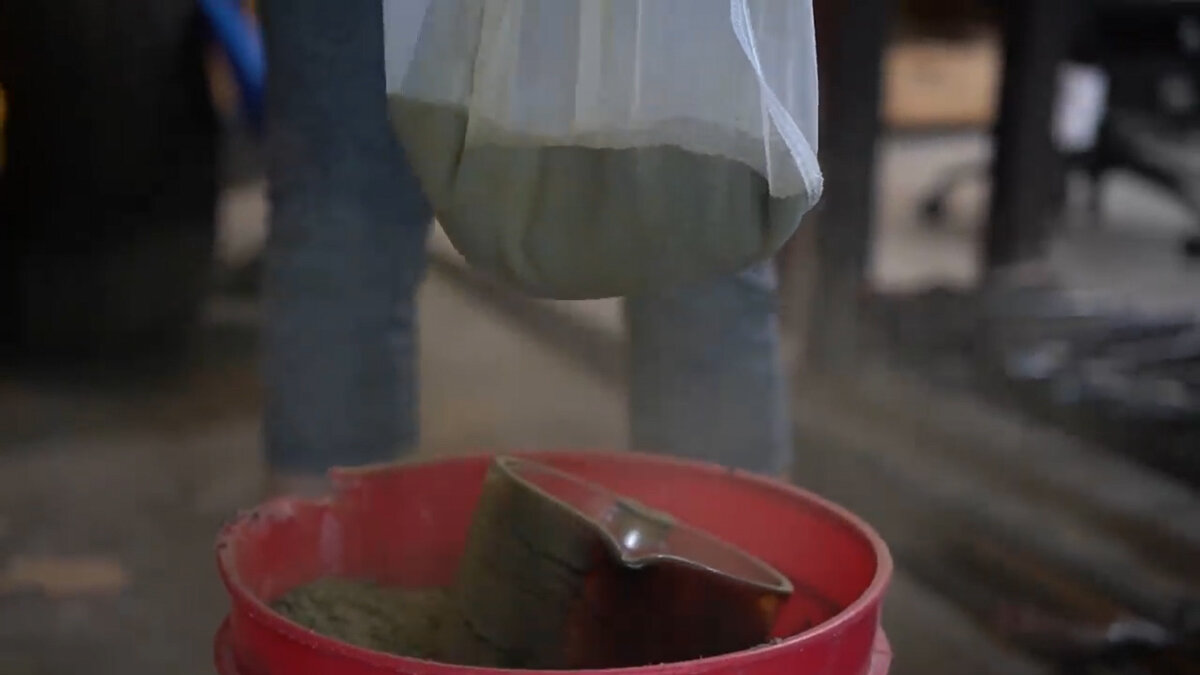Simple Compost Tea Recipe (for JURASSIC-sized veggies!)
The secret to bigger, healthier, pest/disease resistant produce is in the soil, and the secret to improving the health of your soil is this compost tea recipe. Grab my recipe and watch your garden flourish! Then head over and learn how to build your own compost tea brewer.
I started brewing the “lazy” man’s compost tea for five years in Seattle using my own DIY compost tea brewer using a 55-gallon food-grade barrel. My compost tea, in tandem with some other “lazy” techniques, resulted in impressively healthy soil and giant crops.
Alongside my other methods of fixing our soil, including the tips we share in our composting cheat sheet, we’ve been growing monumental amounts of produce (and avoiding the grocery store) with very little effort.
Why Compost Tea?
Growing huge and abundant produce while tending as little as possible is always our goal in the garden. Creating healthy soil is our first priority, and healthy soil starts with good organic compost.
But compost takes time, a lot of human input, and isn’t really an instant fix. Fertilizer can seem like a good shortcut, but it can be expensive, and even a lot of organic fertilizers have stuff we really shouldn’t be putting on our plants or in our bodies.
What if we could create a liquid compost that would provide nutrients immediately available to enhance your plant growth? Enter: compost tea.
What Is Compost Tea?
Compost tea (also known as aerated compost tea) is the single quickest and easiest fix for your garden. It is a fermented liquid that concentrates helpful bacteria, fungi, protozoa, and positive predatory nematodes (the good kind) by distilling these nutrients into a liquid form making it easily absorbed by your plants as a foliar (leaf) spray, or can be delivered directly to the roots of your plants.
At the same time, it improves the health of the soil by adding beneficial microorganisms that result in less watering, and more pest and disease resistance for your plants.
How to Make Compost Tea:
Ingredient Break Down:
Here’s what each of the ingredients does for your plants and your soil, broken down:
Ascorbic Acid - Vitamin C “un-bonds” the chlorine and chloramine from your tap water, provides a little extra something for the plants. It’s an antioxidant, which helps plants deal with stresses from drought and UV radiations. Check out this awesome article in Science Daily for more info on Vitamin C
Liquid Kelp/Kelp Meal - Promotes fungal growth
Unsulphured Molasses - Acts as a food source to promote beneficial bacterial growth (fermentation)
Worm Castings - Provide valuable minerals like iron and desirable micro organisms and fertilize your plants with material that is easily digestible by the plant and won’t burn or damage the plant like some fertilizers can. They improve soil structure, improve water retention in soil, and anchor nutrients that might otherwise leach away with water. They increase seed germination, plant growth, and fruit/flower production. They help curb root and crown rots, wilting diseases and help inhibit certain insect pests like mites, aphids, and mealy bugs. When used as the main fertile component in compost tea, certain vegetables have seen up to a 50 percent increase in growth and yields. - Cornell Vermicompost Research
Azomite - A natural source of trace elements that can improve soil, help combat erosion, and help your plants sequester more nutrient density. It’s extracted from ancient volcanic ash deposits.
Mycorrhizae - Beneficial fungus that increases nutrient and water uptake by a plant by stimulating root growth. It helps plants create a better line of defense against environmental stresses, pathogens, and diseases by encouraging a larger, healthier root system. It also helps improve the soil structure in soils with heavy clay and sand content (like ours here in TN). A good fungal network can transport nutrients over large distances and deliver them directly into the root cells of your plants. The plants support further mycorrhizal fungal growth with energy in the form of carbohydrates that are produced during photosynthesis. Individual plants can become connected with other plants through this mycorrhizal network, sharing nutrients, sugars, and water as well as attracting more soil microbes.
Supplies Needed:
Powdered Ascorbic Acid
Liquid Kelp
Unsulphured Molasses
Worm Castings
Azomite
Mycorrhizae
Compost Tea Brewer Bag
Binder Clips
Foliar Leaf Sprayer
Compost Tea Brewer (Link to her DIY?)
(Many of these items can be found on my Amazon store, when you shop using my link, I get a small commission at no extra cost to you, THANKS!)
The most ideal base for your compost tea is rainwater, but if you, like me, are using city tap water more often than not, you can either run your full brewer for 48 hours before adding anything to it to cause the chlorine/chloramines in the water to dissipate or add 2 tablespoons of powdered Vitamin C (ascorbic acid) to the water.
Running the brewer for a minute after adding the powder should accomplish the same goal. (If you’re cheap like me, and you’ve got some nasty old Vitamin C capsules and a mortar and pestle, this is a great opportunity to offload them.
Vitamin C is also, incidentally, great for your plants, so you get a little extra fertilizer in there right off the bat.
Brewing Compost Tea for 50 Gallons of Water:
2 T. Ascorbic Acid
1 Cup Liquid Kelp (I used 2 cups of kelp meal, mixed with my worm castings because I had it)
1 Cup Unsulphured Molasses
16 Cups Worm Castings
I like to add a couple tablespoons of Azomite and Mycorrhizae as well, just for good measure. Really, you can tweak this recipe as much as you’d like to offer more nutrients in an immediately consumable format to your plants and soil. I’m experimenting with adding tumeric and cinnamon to minimize mold/bad bacteria developing. My next batch will also include a healthy amount of wood ash, a couple TUMS tablets for calcium, and I’ll keep you all updated about what works and what doesn’t! I’ve been wanting to experiment with Diatomaceous Earth and First Saturday Lime as well, but those generally only work in powdered form, so I’m interested to see how they reconstitute in compost tea form as it dries on the plant leaves. * adjusts nerd glasses and moves microscope *
Instructions:
Put the liquid items directly in the water, the powdered items in the compost tea brewer bag, insert the aeration wand, clip the bag in place, and turn on the bubbles! In 24 hours, you’ll have a ready to use foliar (leaf) spray ready to go on your plants.
How to Use Compost Tea:
I spray my tea on my plants at dusk, using a battery-powered backpack sprayer, so I can really control where it goes. I choose dusk to spray because spraying any kind of fertilizer (or any liquid for that matter) in the heat of the day can burn your plants. The liquid droplets magnify the sun on the leaves and can cause a sunburn.
Plants are also more prone to be more susceptible to fertilizer burn during the daytime as well. The runoff from the spray will go directly into your soil and all kinds of magic will start to happen there as well.
Tips:
Use a paint can liner as a compost tea bag.
Use binder clips to secure your compost tea bag inside your compost tea brewer.
I keep my Compost Tea Brewer in my garage because compost tea likes to live between 55 and 80 degrees Fahrenheit.
SUPERCHARGE YOUR COMPOST TEA, the AOAT Way
Test your soil, (life hack: test your compost, too!) and as needed (soil lack or plant by plant requirements), add these items into your compost to address macro and micronutrient needs. Be sure to use chlorine-free /chemical-water for all compost tea concoctions. Use dechlorinated water (from rain barrels, well water, or let municipal tap water sit for 24-48 hours to let the chlorine dissipate or add powdered ascorbic acid (vitamin C) to dissipate the chlorine faster).
Anaerobic Creation of Macronutrient Sources:
Compost (for Nitrogen Phosphorus Potassium, NPK Macros, + Micronutrients) • Amount: 4-5 gallons of well-aged compost (preferably compost rich in plant material, manure, and organic matter). • Preparation: • Fill a large mesh bag (or simply use a 5-gallon bucket with holes drilled in it) with compost. • Submerge the bag/bucket in a large container with 40 gallons of water. • Let it steep for 24-48 hours. Stir occasionally to aerate and encourage microbial activity. • After steeping, strain out the compost and use the resulting “tea” as your concentrated nutrient mix.
Banana Peels (for Potassium) Amount: 6-8 medium-sized banana peels. • Preparation: • Chop the banana peels into small pieces. • Steep them in 2-3 gallons of water for 3-5 days (you can use the same container for both compost tea and banana peel steeping). • After 3-5 days, strain the peels and combine the liquid with your compost tea. This will boost your potassium levels.
Eggshells (for Calcium) • Amount: 1-2 cups of crushed eggshells (about 12-16 eggs). • Preparation: • Crush the eggshells finely, or blend them if you have a food processor. • Add them to 2 gallons of water and let it steep for 1-2 weeks. You can also just add them to your compost tea and let them dissolve as it brews.
Fish Heads/Bones (for Phosphorus and Nitrogen) • Amount: 1-2 fish heads or 2 cups of fish bones. • Preparation: • If using fish heads, chop them into smaller pieces to speed up the breakdown process. • Add the fish pieces to 2-3 gallons of water and let them ferment for 1-2 weeks. Alternatively, use fish emulsion or fish hydrolysate if you have access to it, though the fermentation method is great for adding additional beneficial microbes.
Comfrey (for Nitrogen, Potassium, Calcium, Magnesium) • Amount: 1-2 large handfuls (about 2-3 pounds) of fresh comfrey leaves (or 1-1.5 pounds of dried leaves). • Preparation: • Chop or tear up the comfrey leaves and steep them in 2-3 gallons of water for 3-7 days. • After steeping, strain the leaves and add the liquid to your compost tea. Comfrey is rich in a wide variety of nutrients, including calcium, nitrogen, magnesium, and potassium.
Backstrap Molasses (for Microbial Growth, Trace Minerals) • Amount: 1/4 cup of blackstrap molasses. • Preparation: • Dissolve the molasses in about 1 gallon of warm water and mix it thoroughly. • Add this solution to your compost tea to feed beneficial microbes and increase microbial activity.
Anaerobic Creation of Micronutrient Sources:
Seaweed (I use KELP MEAL) (for Trace Elements, Iron, Boron, Manganese) • Amount: 1-2 pounds of dried seaweed (e.g., kelp or bladderwrack). • Preparation: • Soak the dried seaweed in 3-4 gallons of water for 3-7 days, stirring occasionally. • Strain the seaweed and add the resulting liquid to your compost tea. • Seaweed will contribute essential trace elements like iron, manganese, boron, and zinc.
Wood Ash (for Potassium, Trace Elements, and pH Adjustment) • Amount: 1/2 to 1 cup of finely sifted wood ash. • Preparation: • Add the wood ash to 2 gallons of water and let it steep for 1-2 days. • Strain the liquid and add it to your compost tea. Wood ash is a great natural source of potassium and trace elements, and it can help adjust the pH if it’s too acidic.
Nettle or Alfalfa (for Trace Elements and Nitrogen) Amount: 1 pound of dried nettle or alfalfa. • Preparation: • Chop or tear up the plant material and steep it in 2-3 gallons of water for 1-2 weeks. • Strain and add the liquid to your compost tea.
Dilution Rate:
A 1:50 dilution of your concentrated tea should be a good starting point for foliar sprays and when using in hydroponic systems as we don’t want to overwhelm the foliage or sensitive root systems of our plants. 1 gallon of concentrated tea per 50 gallons of water. • If you want to mix up 1 gallon of diluted fertilizer, use 1/20th of a gallon (roughly 6.4 oz) of your concentrated fertilizer and add it to 20 gallons of water.










